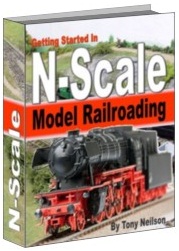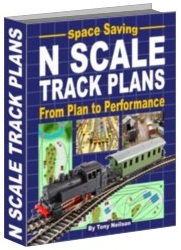|
What does
it cost to build an N gauge model railway layout or to buy one
ready-made? Let’s just look at one and the costs of buying one ready-made
or custom made. People sell their already complete layouts from hundreds
to thousands of dollars. At the same time I know of folks who spent
several thousand dollars to build their model railway layouts. Then if
you want a custom build layout what does that cost?
Buying a
Layout versus Building and Layout
For our
purposes here we are going to assume that you are building the model
layout from scratch with a combination of patterns and kits as well as
doing it all without kits. These railway layouts are not just off the
shelf kits. There may be some components that are off the shelf, like
trees or bushes, but even the buildings are not straight from a
kit.
Buying a
Layout Complete
Here are
some examples of completed layouts that are currently for sale on eBay
and Craigslist. These are not kits from which to make your layout. These
are completed and mostly custom layouts. Please note these examples are
from real advertisements that appeared at the time this article was
written. This website does not offer model railway layouts for sale -
these are examples only.
N SCALE,
CUSTOM BUILT LAYOUT, 11 FEET 5 INCHES X 23 INCHES
$375
Shipping $128.50
Custom
built 11’ X 5’ and 23” wide. 3 separate sections. Mounts to the wall with
12 screws must go into wall studs. 3 sections are made of MDF with pine
laminate for edging. 9 ¾ inch radius for the track. TRACK NOT INCLUDED.
No scenery or structures. Layout ONLY.
N-Gauge
Old West Train Layout
$3000 plus
local pick up only
This one
is 37” by 65” with an overhead system of lighting and with backdrops.
Includes trains Athearn engine, roundhouse, Bachmann cars. Includes
bridges, trestle, cows, tunnels, boats, silo, cars, buildings, people,
horses, logs, wildlife, and lakes. MRC railpower 1300 power pack with
sound generators. Impressive layout.
N Gauge
Model Railway Layout
$1500 plus
local pick up only
Layout
ONLY. NO trains or power packs. 9’X3’ all new Peco and Atlas tracks. New
turnouts, gates and set up like Washington DC. Able to run two trains at
same time – park 4 complete trains. Lit backdrops. All structures,
buildings, trees, bushes, bridges and more.
Custom
n-gauge Kato layout w/backdrop/wired
$995 plus
shipping $90
This is
custom that was started with a Kato kit. Backdrop on 3 sides, set can be
changed with several options. Track plan, mountain tunnel, seasons, pond
and waterfall, 24 pine trees, 2 switches, 1 bridge, 1 double crossover, 2
bumpers, straight and curved track included, bridge, 3 seasons, smaller
mountains, 24 deciduous trees, special effects, lichen, and moss. 2 train
operations possible, yard track,
NOT
INCLUDED: Trains, transformers, roads, houses, figures, signs, and
lights.
N Gauge
Custom Built 3 X 6 Kato Layout with Vertical Lift Bridge
$3750
includes shipping. Cost is $3350 if you pick it up. ($400 shipping
allowance)
3X6 foot
layout for two trains at once and motorized turntable. Passenger
platforms, train station, two removable sections of upper level diorama.
Custom made with Kato Unitrack
wired for DC and DCC. All structures, streets, sidewalks and ground cover
included. Built the way you want it built with all new materials.
N GAUGE
TRAIN LAYOUT
$1799 plus
$45 minimum shipping more depends on location
Custom
built when ordered. 32” X 56” using Kato
Unitrack with two independent operating loops. Crossover turnout
everything already wired. Bridges, turnout controls, Lightweight 2” foam
board construction grade and durable. Takes 2 months to make. No two layouts
are alike. Power packs and buildings not included but can be added at
cost.
So you can see from these examples that if you have a n gauge model railway
layout built for you it can be incredibly expensive, you do not have the
satisfaction of building it yourself and there is always the issue and cost of
shipping. As you can see from some of these examples shipping can cost at
minimum about $100 and with the larger units it can be as much as $400 or
more.
Please note the above model train layouts are not being sold by this website
and are simply examples of n gauge model railways advertised for sale at the
time of writing this article.
|
Recommended
Model Train Resources

Getting
Started In
N Scale Model Railroading
Click Here To Watch
Video

Space
Saving
N SCALE TRACK PLANS
From Plan To Performance
Click Here To Watch
Video
What’s different between HO and OO?
HO Scale is commonly used in
the USA and in various countries worldwide including Australia and New
Zealand. It is bigger than N scale and is the most popular scale
worldwide.
OO gauge is very similar in
size to HO, and is the number one seller in the United Kingdom. The gauge
of the track is the same, remembering that gauge relates to the actual
distance the rails are apart and not to the scale size. OO gauge and HO
is 16.5 mm between the rails.
However, the scales are
slightly different. OO scale is precisely 1/76th of the real size, or put
another way, 76 times the models length equates to one real sized item.
OO scale is 4 mm to the foot, meaning 4 mm on a model equates to one foot
in true life. Based on that, a person who is six foot tall in real life
would be 24 mm tall in model sizing (6 times 4 mm = 24
mm).
Compare that to HO scale which
is 1/87th of real size, or 3.5 mm to the foot. Using the earlier
scenario, a person six foot tall would be 21 mm tall (6 times 3.5 mm = 21
mm).
The two
scales are very close, so that’s why manufacturers decided on using just one
gauge for both OO and HO.
N Gauge Railway Layouts
N Gauge Buildings
N Gauge Model Railway Layouts
Small N Scale Layout
N Scale Scenery
N Gauge Track Plans
Miniature
Scenery
|

